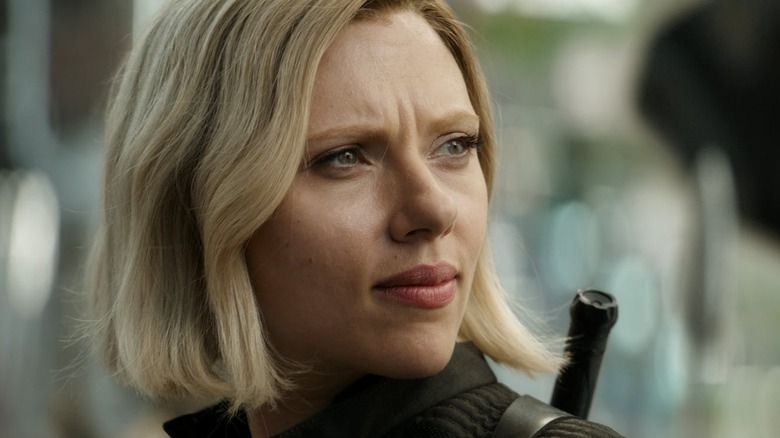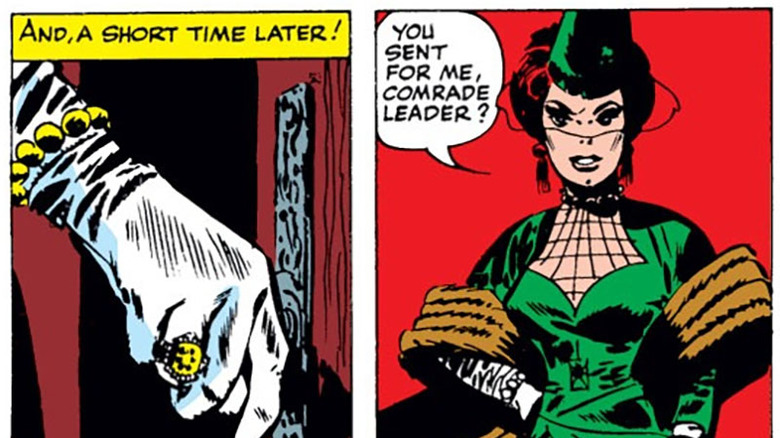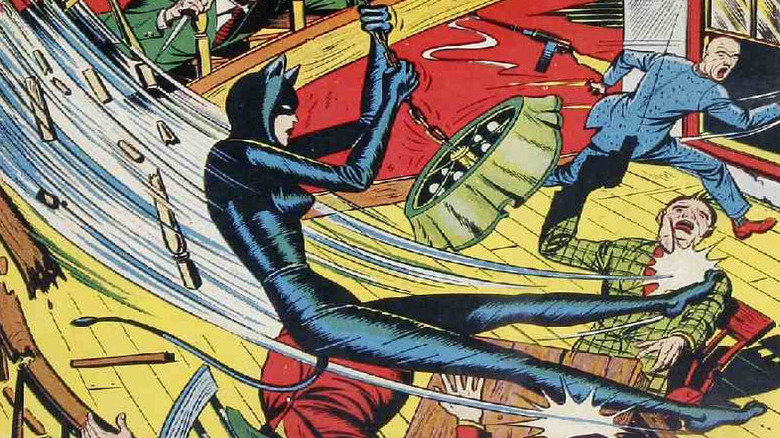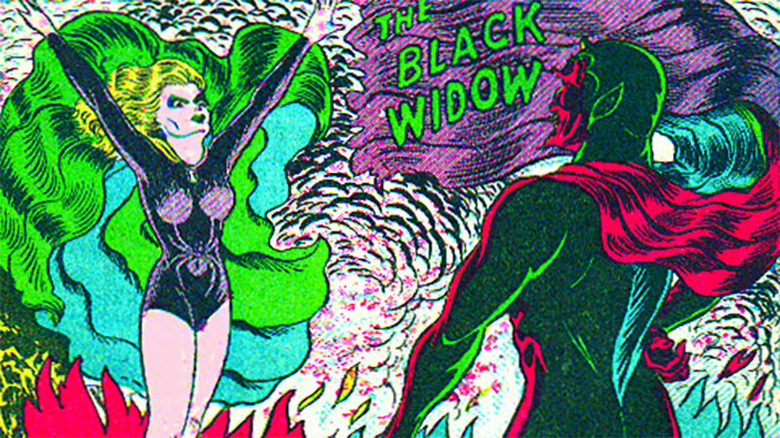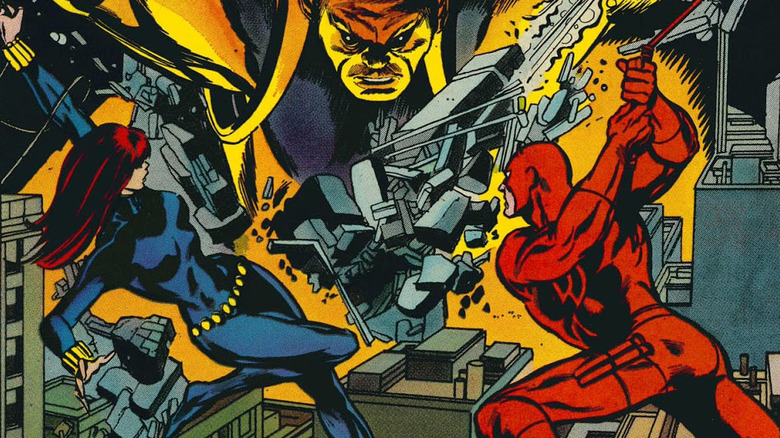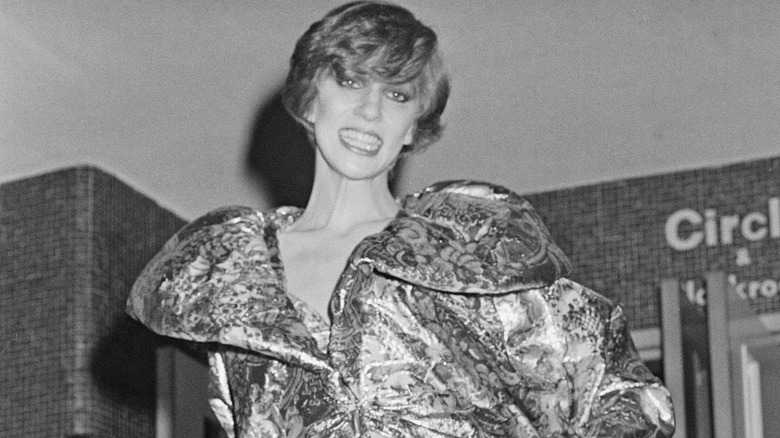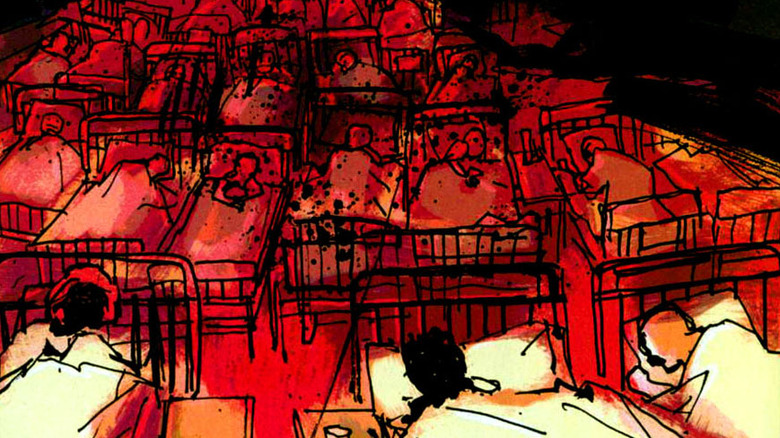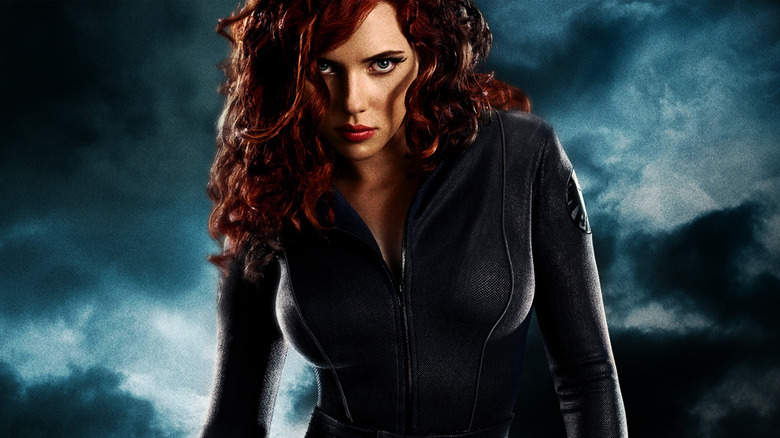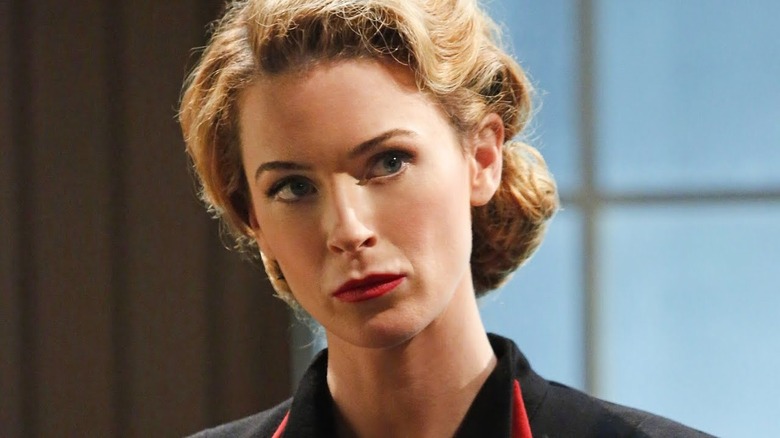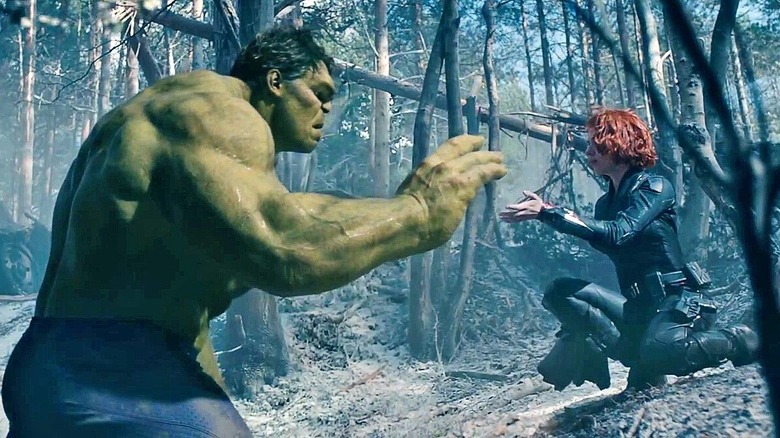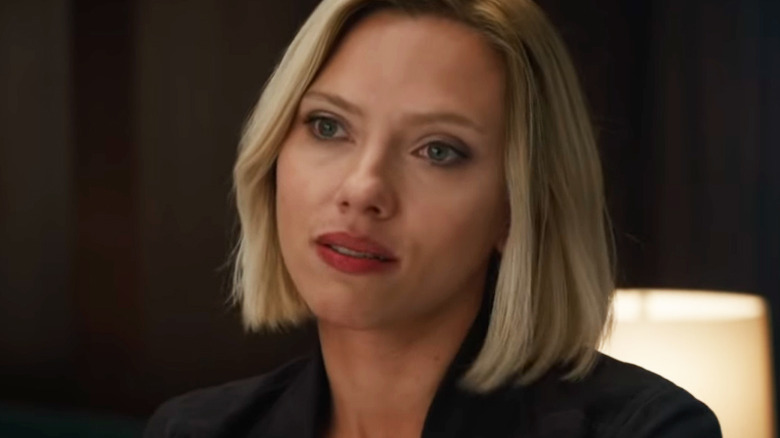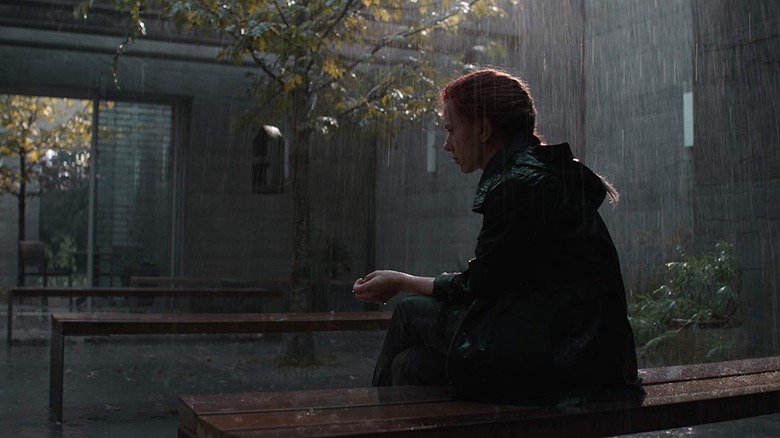The Untold Truth Of Black Widow
It's been a long, hard road for Natasha Romanoff, the super-spy with the codename Black Widow. In a world full of superheroes wearing bright and colorful costumes, she's something different: a woman who sticks to the shadows, who flexes her mind just as often as her muscles, and who doesn't mind crossing a few lines to get the job done. None of that's slowed her down: She's gone from Soviet infiltrator to an agent of S.H.I.E.L.D. She's led the Avengers, and became a star on the silver screen in the MCU. In short, if there's something to do in the Marvel Universe, the Black Widow's probably done it.
And yet, like any secret agent worth her salt, Natasha still has her secrets. A murky past. A stolen costume. A big-screen career that's been mired in controversy. Thankfully, we've got all the details for you here, but don't go spreading this intel around. Spies like their privacy, and the Black Widow is no exception — and trust us, you don't want to get on her bad side.
A disguise so good, you'd never recognize her
Black Widow made her first appearance in 1964, but if it weren't for the name, you wouldn't know it's her. Not only is Natasha missing her black catsuit and signature red bob, but in her debut, she's not the heroic spy you've come to know and love. She's evil all the way through.
In fact, in her debut, Natasha doesn't even fight. During one of Iron Man's first adventures, he fought Anton Vanko, an Soviet scientist who's also known as the Crimson Dynamo, and then helped him defect to the United States. In Stan Lee and Don Heck's Tales of Suspense #52, the Soviet Union sends the Black Widow and her partner, the super-strong secret agent Boris Turgenov, to the U.S. to get revenge. While the widow uses her feminine charms to seduce and distract Tony Stark (honestly, it doesn't take much effort), Boris attacks Vanko and steals his super suit.
The Black Widow is a little more active her next outing, Tales of Suspense #53, and she gets her own costume in Tales of Suspense #64, although it's a fishnet-heavy mask-and-cape ensemble, not the skintight jumpsuit she's known for today. Still, during these early appearances, Black Widow is little more than a Cold War-era stereotype: the glamorous and beautiful femme fatale who uses her looks to manipulate men into doing her dirty work. It'd be a while before Natasha emerged as a complex, capable, and fully independent character. Still, better late than never.
Need a better look? Steal someone else's!
You know Black Widow's most iconic costume. You've seen it a number of times in films like Iron Man 2, The Avengers, Age of Ultron, and Captain America: Civil War. The form-fitting black suit. The bright red hair. Those stylish (and ultra-dangerous) bracelets, better known as the Black Widow's Bite.
As it turns out, none of those belonged to her — at least, not originally. In 1941, a costumed hero named Miss Fury debuted in newspapers' comics sections, and her outfit should look very familiar to Black Widow fans. Like Natasha, socialite Marla Drake slipped into a sleek black outfit — one made out of panther skin, in Fury's case — when she stepped out to fight crime. Miss Fury wasn't the first female superhero, but she was the first female superhero created by a woman, and she quickly gained a number of fans.
Legendary Marvel artist John Romita Sr. is among them. In 1970, while illustrating Amazing Spider-Man, Romita learned that Marvel had the rights to Miss Fury (Marvel's predecessor, Timely Comics, used to publish compilations of Fury's newspaper strip). Romita told his Spidey collaborator Stan Lee that he'd love a chance to draw a Miss Fury book someday — she was one of Romita's favorites when he was a kid — and Stan suggested that they just make Black Widow into Miss Fury instead. Romita traded Miss Fury's mask for the Black Widow's shock of red hair, and the revamped Black Widow debuted in The Amazing Spider-Man #86. The look's been Natasha's ever since.
A Marvelous first — with one big caveat
Black Widow was Marvel's first female superhero, but there's a catch: she's not the Black Widow you're thinking of. The Black Widow that Timely created in 1940 was a psychic named Claire Voyant (yes, seriously) who was murdered after a seance went bad, only to be brought back to life to work as a superpowered servant of Satan himself. In fact, her whole gig was murdering evildoers so her boss could harvest their condemned souls a little faster. Yeah, it's real weird.
Our Black Widow might've missed out on being Marvel's first superheroine by a couple of decades, she does have one big advantage over her predecessor: Natasha Romanoff was the first Black Widow to get her own ongoing feature. Claire Voyant only appeared a handful of times, and never had a regular book to call home. The second Widow, meanwhile, helped kick off the second volume of Amazing Adventures. According to the comic historians at TwoMorrows, Natasha was even the first female Marvel hero to star in her own regular feature, although Golden Age heroes like Timely's Ms. America, Namora, and the Blonde Phantom make that claim a little complicated.
Unfortunately, the Black Widow's first stint as headliner didn't last very long. While Natasha's strip blended stunning artwork with pointed social commentary, her Amazing Adventures co-stars, the Inhumans, proved much more popular, and the Black Widow's solo outing ended after eight installments.
When Daredevil needs help, Black Widow swings to the rescue
Thanks to writers and artists like Frank Miller, Brian Michael Bendis, Mark Waid, and Ed Brubaker, Daredevil has become one of Marvel's most popular heroes, especially among hardcore comic fans. In 1971, however, ol' hornhead was in trouble: His ongoing book wasn't selling all that well. Creatively, things were stagnant.
Marvel originally decided to shake things up by putting Iron Man and Daredevil in the same comic, but Daredevil writer Gerry Conway came up with a different idea. As Conway remembers, "I was a fan of Natasha, and thought she and Daredevil would have interesting chemistry" (although he admits that he might've just liked Black Widow because he's a "sucker for redheads"). He was right. The Widow joined the Man Without Fear in Daredevil #81 and stuck around for over 40 issues. She even got her name added to the title of the book in Daredevil and the Black Widow #93, where it stayed until #108.
Sales rose accordingly, and with Black Widow as a co-star, Daredevil rediscovered its groove. During Black Widow's run on the title, Natasha and Matt Murdock started dating and moved to San Francisco (allegedly, showing an unmarried couple living together got Marvel in trouble with the Comics Code Authority). When writer Steve Gerber took over the book, however, it meant an end to Marvel's biggest power couple. When Matt's best friend, Foggy Nelson, was shot, Daredevil headed back to the Big Apple to help. Black Widow stayed behind. "I didn't miss her," Gerber said. "Daredevil works better as a loner."
The original Glass Spider?
Comic book fans weren't the only ones who thought Daredevil and Black Widow made a great couple. Angela Bowie, a model, actress, and wife of rock legend David Bowie, thought so too. In 1975, shortly after losing out on the lead role in a Wonder Woman television movie, Bowie bought the rights to Daredevil and Black Widow and started developing a TV series in hopes of giving her acting career a big boost.
It didn't work out. Bowie recruited Shadows and The Dirty Dozen star Ben Carruthers as Daredevil and had Natasha Korniloff, who helped Angela's husband come up with some of his most outrageous costumes, design the outfits. The couple took some promo shots to help sell the show to networks, but that's as far as the project ever got. No scripts were written, no scenes were filmed, and no studios were interested in buying the show.
Years later, Angela Bowie told the fan site Man Without Fear that the proposed superhero show was simply too expensive and complicated for networks to tackle back '70s, and accordingly, the project struggled to find a home. We still don't know exactly what Bowie's take on the Black Widow would've been like, but don't feel too bad for her: after divorcing David in 1980, Bowie went on to become an accomplished author and journalist, not to mention a Celebrity Big Brother contestant.
More super than you think
In the movies, Natasha doesn't have any real superpowers. She's just really good at sneaking, fighting, and blowing things up. Like any spy worth her salt, Black Widow has lots of handy gadgets to help her out, but at the end of the day its her training, quick reflexes, and razor-sharp mind that lead the way to victory.
In the comics, things are a little different. For the most part, writers and artists tend to attribute to Natasha's superior abilities to her time at the Red Room, a Soviet training facility. One story, however, reveals that Natasha's got something a little more special running through her veins. In 2004's six-issue Black Widow series, Natasha learns that the Red Room brainwashed her and 27 other orphans, gave them false memories, and injected them with a special super soldier serum to make craft them into weapons.
Thanks to Natasha's chemical enhancements, she heals four to five times faster than a normal human, doesn't ever get sick, and ages much, much slower than she should. In addition, the Red Room developed a special pheromone spray that prevents its agents from attacking anyone who's wearing it — a product that Nick Fury's used again and again to keep Natasha in line. While the Red Room remains a major part of the Black Widow's origin story, her superpowers almost never come up, probably to keep the comics' Natasha in line with her big-screen counterpart (although, we've gotta say, the idea that the Widow gets by on her skills and wits alone is also just much, much cooler).
Natasha versus Tony Stark in the race to the silver screen!
It's the same old story. Studio executives are surprised when female-led action flicks do big business at the box office, and suddenly, everyone is rushing to capitalize. That's certainly true in 2018, when Wonder Woman's success has Marvel feeling a lot better about its upcoming female-led superhero adventure, Captain Marvel, and a possible Black Widow solo flick. Don't get too excited, though. Natasha's been down this road before, and it didn't have a happy ending the first time around.
In 2004, four years before Tony Stark jump-started the Marvel Cinematic Universe, Tomb Raider and Kill Bill proved that female action stars appealed to audiences just fine, and Lionsgate wanted in. The studio hired actor and screenwriter David Hayter, who'd just penned the scripts for the first two X-Men movies, to bring the Black Widow to the big screen. Hayter's screenplay followed the comics pretty closely, and the writer was all set to step into the director's chair when Lionsgate pulled the plug.
As Hayter explained, in addition to all those female-led action movies that did well, "we had BloodRayne and Ultraviolet"... which did not. The Charlize Theron-led flop Aeon Flux was the last straw. After that failed, Lionsgate decided not to go forward with Black Widow. That's a bummer for Hayter, who loves the character so much that he named his daughter Natasha, but it's even worse for the Widow's fans. While Natasha finally made her feature film debut in 2010's Iron Man 2, Black Widow's been a sidekick for almost a decade. We're still waiting for that solo movie — and waiting, and waiting, and waiting.
Black Widow 1.0
Natasha wasn't the first Black Widow in Marvel Comics, and she wasn't the first Black Widow in the company's cinematic universe, either, although you wouldn't know if you didn't watch Marvel's Agent Carter — which, judging by the ratings, you probably didn't.
On the series, Hayley Atwell reprised her role from Captain America: The First Avenger while offering fans a glimpse inside the Strategic Scientific Reserve, S.H.I.E.L.D.'s predecessor. As one of the SSR's only female agents, Peggy Carter must battle sexism in the workplace while also doing her best to topple Leviathan, a Soviet espionage agency with eyes for Howard Stark's genius and deadly inventions. Throughout the show, Carter butts heads with a Leviathan assassin known only as Dottie Underwood, who serves as Peggy's evil counterpart — and who also happens to be the MCU's first Black Widow.
Agent Carter never actually uses the Black Widow codename for Dottie, but if you're paying attention, it's clear (and if you're not, the show's producers confirmed the connection). Like Natasha, Dottie is a product of the Red Room training program. Like Natasha's, Dottie's been trained to be both quick-thinking and ruthless. They even fight like one another: once actress Bridget Regan realized where Agent Carter was taking her character, she studied Scarlett Johansson's fight scenes in order to make sure that both spies had the same style.
Not your plaything — or anybody else's
Scarlett Johansson's Black Widow is one of the very best parts of The Avengers: Age of Ultron, but you wouldn't know it from the film's merchandise. While all of the other Avengers were front and center on toy store shelves, Natasha was noticeable only in her absence. Heck, in the action figure versions of Black Widow's coolest scene — you know, the one where she rides a motorcycle out of the back of a moving quinjet — Hasbro replaced her with Iron Man and Captain America.
That's not just an oversight. It's a sexist trend, and it can all be traced back to one man: Ike Perlmutter, the former Toy Biz executive who bought Marvel in the '90s and sold it to Disney in 2009. Allegedly, Perlmutter thinks that "girl toys" don't sell, and used his position as Marvel CEO to veto Black Widow merchandise again and again.
It wasn't just fans who were disappointed by the lack of Widow collectibles. Mark Ruffalo, who plays Bruce Banner and the Hulk in the MCU, took Marvel to task on Twitter. In 2016, an embarrassed Marvel Studios President Kevin Feige (who, notably, hasn't answered to Perlmutter since shortly after Age of Ultron premiered) promised that things would get better. At least Natasha's in good company: The Guardians of the Galaxy's Gamora was similarly excluded from the first movie's merchandise, while Rey, the lead character in Star Wars: The Force Awakens, received similar treatment when her movie came out.
Black Widow 1, Joss Whedon 0
At first, Joss Whedon and Black Widow seemed like a match made in heaven. Whedon rose to fame as the steward of complex and compelling female action heroes on shows like Buffy the Vampire Slayer, Angel, and Firefly, and his geek cred is beyond question. If anyone in show business could get Black Widow right, fans seemed to think, it'd be Joss. Scarlett Johansson thought so too. Johansson says, "When I read [the Avengers script], it was just like, 'Oh, thank you, Joss!'"
Things worked out pretty well for the first Avengers movie. The second? Not so much. In Age of Ultron, Natasha gets a lengthy subplot dedicated to her budding romance with Bruce Banner, and at one point she stops to explain why they'd make a great couple. He's a monster, she says, because he's got the Hulk lurking inside of him. She's a monster, meanwhile, because the Soviet scientists in the Red Room sterilized her while transforming her into a super-spy, robbing her of the ability to do her motherly duties.
That's straight out of the comics, in which the Red Room's super soldier serum turns women's bodies against their own wombs, but fans still weren't thrilled with the scene's misogynist undertones, which seemed to reduce a fascinating character to the sum of her reproductive parts. They let Whedon know. In the aftermath, Whedon quit Twitter — he claims that the social network was simply too noisy, although he also admits that a lot of that noise came from complaints — and later tried to explain that the "monster" line was referring more to Natasha's murdery past than her infertility. It was too little, too late. The damage had already been done.
A different look
After the events of Captain America: Civil War, Natasha Romanoff chose the side of Captain America and went on the run with Cap, Falcon, and Wanda Maximoff to form an underground superhero team. By the time of Infinity War, Team Cap was still running missions, an arrangement that was complicated by Wanda's budding love affair with Vision. During this undercover period of their lives, Team Cap was forced to keep a low profile — or as low as superheroes can, at least — and that included a slightly new look for Natasha: Her trademark red hair was dyed blonde.
According to Johansson, the change in hair color was a request from directors Joe and Anthony Russo, who wanted the characters to look like they'd made efforts to disguise themselves and show evidence of the passage of time. It was also a bit of an homage to the other major Black Widow in Marvel Comics, Yelena Belova.
"They just wanted us to look different, and so for me, I thought, all right, well maybe I'll give it a little wink and nod to the other Widow's kind of story that has been burned out," Johansson said.
Two families
Throughout the Marvel Cinematic Universe, we've got only glimpses of Black Widow's past life as a Russian assassin, but it's clear from those glimpses that her early years were far from easy. She was recruited, trained, sterilized, and taught to kill without mercy, and she eventually managed to overcome all of that to be a hero. In Avengers: Endgame, Natasha must reckon with both sides of this existence. She notes early on in the film that she "had nothing" before the Avengers, and that she thinks of the team as her family, and as her reason to keep trying to be a better person even in a post-Thanos world.
When Natasha and Clint Barton are dispatched to Vormir to get the Soul Stone, we learn via the Stonekeeper (aka Red Skull) that her father's name was Ivan. This is significant because it's information not even Natasha herself knew until then. She was so ignorant of much her family's history that her own father's name was a profound revelation, reminding her of where she came from, and the redemption she was seeking to earn through her heroics.
